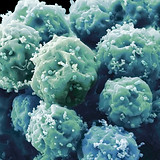Common Ilnesses
Coccidiosis in Bearded dragons is very common and should be tested for at least every 3 months. It is commonly seen in stressed Beardies, especially in neglected and unhygienic enclosures. As with all infected animal species, coccidia invade the gastrointestinal tract and cause cellular damage, giving rise to various degrees of diarrhoea. If uncontrolled or untreated, coccidiosis can even lead to death! This species specific disease spreads from one animal to another by contact with infected faeces. In the majority of cases diarrhoea is the primary symptom.
Treatment should consist of a combination of medication and fastidious and regular environmental control. While treatment is not always difficult, eradication of the coccidian parasite in the environment can be extremely difficult. Hygiene also plays a huge roll in the prevention and control of these parasites. Treatment should only commence under the supervision of a experienced reptile veterinarian.
Internal parasites
Impaction is a serious condition where the intestines get blocked with faeces. In Bearded dragons it is most often caused by the ingestion of sandy or gravel substrates. There are various underlying and husbandry related problems leading to Bearded dragon impactions. Ingesting sand and gravel are frequently the cause of impactions in Bearded dragons. Eating mouthfuls of sand or soil are often secondary to calcium deficiency, or metabolic bone disease. Accidental ingestion of gravel (or any other foreign body) often leads to impactions and blockages. Other problematic substrates include gravel, pebbles, corn cob and bark products.
Treatment includes, firstly changing substrate to something more appropriate. Milder cases can respond to at home treatments such as laxatives ( with things such as coconut oil), careful force feeding and luke-warm baths regularly. Severe cases it might need hospitalisation for intensive treatment. In hospital, drips, medication for vomiting, antibiotics and force feeding might be used. Some impactions will also benefit from enemas. Surgery, i.e. opening of the intestines or stomach this is risky, but can be life saving and can be considered as a last resort. Correct husbandry can reduce the risk of this occuring.
Impaction
Adenovirus infection in Bearded dragons is a life threatening, potential disastrous and emerging disease in these lizards. It is cause by a virus causing major liver disease and death in lizards. Adenovirus infections are not fully understood in Bearded dragons, but is often in conjunction with other infections such as coccidiosis.The only way to diagnose Bearded dragon Adenovirus is via a post mortem (necropsy). Even after death, there is no significant visual or so-called macroscopic lesions visible and microscopical or histopathological evaluation is necessary to see the lesions caused by the virus.
at the moment there is no treatment for the disease. Symptomatic treatment in sick (but not necessarily confirmed) Bearded dragons, which include antibiotics, force feeding and parenteral fluids (drips) seems to work in the short term and increases the survival rates of some suspected infected Bearded dragons. Treatment should preferably be done under the supervision of an experienced reptile-friendly veterinarian.



